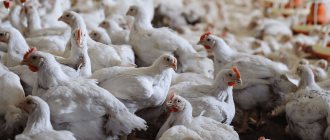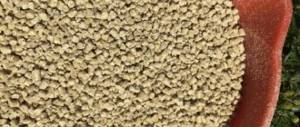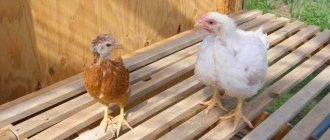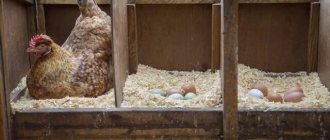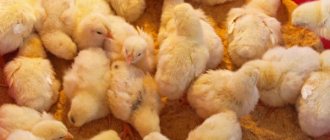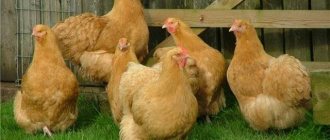Advantages and disadvantages of cellular content
Pros:
- saving space - placing more heads in the same area;
- reduction in fattening time , which leads to an increase in farm profits;
- increased live weight gain and more production per unit area compared to other methods of raising broilers;
- due to the physical restriction of the poultry’s physical activity, the consumption of feed by broilers is reduced , which, accordingly, reduces the total consumption of feed mixtures;
- due to the lack of bedding, the question of its constant replacement is eliminated;
- reduction of energy costs for heating, lighting and ventilation;
- there is a tray for collecting litter , which is often cleaned;
- presence of a feeder and automatic drinker;
- limiting contact between birds and each other , which leads to a reduction in the risk of epizootic and invasive diseases;
- less need for maintenance personnel , which means reduced costs.
Minuses:
- cage equipment is more expensive than floor equipment;
- complexity and labor intensity of disinfection and cleaning of cage equipment;
- lower quality level of veterinary care , labor intensity of vaccination;
- increased risk of infectious epidemics due to overcrowding of chickens;
- higher percentage of mortality and culling of birds;
- presence of skin deposits on the breast bone of broilers;
- Leg problems in overweight birds due to mesh flooring;
- the difficulty of ensuring uniform lighting , heating and high-quality ventilation;
- difficulty achieving uniformity of livestock weight;
- decreased taste of meat and eggs.
How to properly organize a broiler business?
Read
Chickens for slaughter - when can birds be used for meat?
More details
Broilers are meat chickens that are genetically engineered for rapid weight gain.
Look
The best breeds and crosses of Russian chickens: top 5 most productive chickens
Further
Advantages of cell technology over floor cultivation
The main advantages can be expressed as follows.
- Rational use of poultry house premises. From one meter of area you can get almost three times more meat products. In particular, this is achieved by using multi-tier cell batteries.
- Simplifies and allows mechanization of cell maintenance.
- Facilitates provision of standard parameters for temperature, air exchange, and lighting.
- Allows you to maintain better sanitary and hygienic conditions.
- It is convenient to monitor the general condition of the bird.
- There are no problems with litter and its disposal.
- Broilers have no contact with droppings. And, as a result, they are less likely to be exposed to such a terrible chicken disease as coccidiosis.
- All the energy of the feed is spent on weight gain, and not on movement, as a result of which they reach slaughter weight faster.
Based on these provisions, raising broilers in cages is beneficial not only at poultry farms, but also on private farms. Even if you do it only for your needs and not for sale.
recommended articles:
- Caring for turkey poults: how and what to feed from the first days
- How to raise ostriches: organizing a small mini-farm
This means that if you decide to use cell technology, you need to acquire a cell. You can read about the types of ready-made cages and the zootechnical standards for keeping chickens in them in the article “Cage keeping of laying hens at home.”
Purchasing a ready-made cage is too expensive. Therefore, most often small farms use homemade structures. But in order for it to comply with all regulatory requirements, you first need to draw up a plan of preliminary measures.
Conditions for growing broilers in cages
The health and productivity of broilers depend on the proper organization of space with cages and their equipment, as well as compliance with zootechnical standards and a favorable microclimate.
Cell requirements
The preferred material of manufacture is galvanized steel rod with a diameter of 2 mm, for the floor - at least 3 mm. Some manufacturers produce cages with plastic floors, which helps reduce bird injuries. The optimal cage depth is 30 cm, height – 25 cm. The width depends on the number of chickens housed:
- up to 50 cm – 3-4 broilers;
- up to 70 cm – 6-8 broilers;
- up to 120 cm – 10-12 broilers.
The cell can be a single block or a system of cells combined in height and width. In large farms they are placed in batteries - 2-3 tiers in height.
Block cells are often divided in the center by a partition into 2 cells. Cells are placed with free access to them.
Cell equipment
Broiler cages are equipped with the following equipment:
- trays for collecting and removing litter;
- heating and lighting devices;
- thermometers for measuring temperature in cells;
- feeding and watering systems;
- ventilation.
The front wall of the cages may have a sliding door, closed with a latch, for disembarking broilers. If there are several tiers, wheels are installed for easy movement of the blocks.
Raising chickens
Not all breeds of chickens have a pronounced brooding instinct. This article will tell you how to train a chicken to brood.
Therefore, in some cases it is recommended to purchase incubators. Read more about incubating chicken eggs. Also, for further rearing for slaughter, chicks can be purchased from specialized farms.
Daily allowance
As soon as the chicks are born, they must be placed in a separate dry box lined with paper, cloth or soft hay. It is important that newborn chicks are always kept warm. To ensure optimal temperature, it is recommended to install an incandescent lamp on top. Or you can qualitatively equip a brooder for broiler chickens.
It is better to purchase broiler chickens for growing from experienced breeders or poultry farms.
Chickens should be fed with a finely grated boiled egg. It is important to accustom them to this feeding regime from the very first days, otherwise problems with food intake may result in death from starvation. Water must be present in the drinking bowls at all times. It is best to choose heavy and deep containers that are difficult to turn over.
Lethargy of the chicks and a constantly open beak may indicate that the temperature in the box is too high.
Weekly
Week-old chicks should also be kept warm and dry. The basis of the diet of broiler chickens at this stage of development can be a boiled egg, dry cottage cheese, corn grits, millet or a specialized feed mixture for chicks. It is also useful to give finely chopped soft grass, yogurt, and periodically drink them with a weak solution of potassium permanganate.
During the first week of life, the bird needs to be fed 8 times a day.
Menstruation
By the age of one month, a chicken usually gains about one and a half kilograms of weight. The number of feedings at this stage should be reduced from six to three or four, and the basis of the diet can be a special feed mixture, fermented milk products, boiled potatoes, and fresh seasonal vegetables. It is also allowed to prepare mash based on mixed feed.
Chicks over the age of one month should not be kept in boxes. At this stage, it is recommended to transfer them to separate cages or chicken coops. The temperature in such rooms should be maintained at twenty to twenty-five degrees Celsius.
At one month of age, the starter feed is replaced with growth (granulated) feed.
Two months old
You can feed two-month-old chickens with “adult” food two to three times a day. The basis of the diet during this period can be feed and grain mixtures, greens, seasonal vegetables and root vegetables. It is important that chicken coops contain containers with river sand or small shell rock. The weight of broilers at two months of age should be up to three kilograms.
Microclimate and zootechnical standards
Important elements of the microclimate when raising broilers in cages are temperature, humidity, ventilation and compliance with the light regime.
Temperature and humidity
In a chicken coop with cages, it is necessary to maintain a constant temperature, which is controlled using thermostats that automatically maintain the thermal level.
For local heating use:
- infrared lamps;
- electric heaters;
- ultraviolet irradiators;
- gas heaters (require a license, so are more suitable for farms).
The temperature depends on the age of the broilers:
- 33-35° – for chickens from 1 to 7 days;
- 26-29° – 8-21 days;
- 20-22° – from 3 weeks of life.
Expert opinion
Sadchikov Nikolay Alekseevich
Veterinarian ornithologist
Ask a Question
The relative humidity level in the room should be 60-70%. The state of the birds' respiratory system and the perceived temperature depend on it.
With a high level of humidity during the hot season, the temperature is felt higher than the existing one. At low humidity, broilers lose more fluid.
Broiler cage rating: TOP 9 models
Read
The influence of temperature on broiler chickens
More details
Daily weight of broilers from birth to 60 days of life
Look
Ventilation
Boilers that are 21 days or older generate a lot of heat, which produces ammonia and carbon dioxide fumes, which can cause various diseases and lead to reduced feed intake and weight gain. Therefore, if there are a large number of broilers in the chicken coop cages, a forced ventilation system (air supply and removal) is needed to provide fresh air year-round, which also helps reduce high air temperatures in the summer. The organization of forced ventilation is calculated per kilogram of live weight of the bird per hour and amounts to 1.5-2.0 m3 in winter, 4.8-9.6 m3 in summer. The outside air temperature is taken into account.
Light mode
The duration of daylight for broilers is 15-18 hours, and for chickens in the first two weeks of life - around the clock. From the third week until slaughter, alternating periods (intermittent lighting) are practiced: 1 hour of light, 2 hours of darkness.
According to the standards, for 4 sq. m of poultry house requires 100 or more watts of lighting from incandescent lamps or 12 watts of LED lighting.
The light regime for broilers is aimed at stimulating feed consumption.
Making cells with your own hands and arranging the room
Breeding broilers requires a careful approach to all the nuances. You can buy cages, but it will be much cheaper, and often better quality, to make them yourself. Industrial cages are designed for a large number of tiers and have increased capacity. At home, this is not always necessary.
It will be useful for you to learn how to make broiler cages with your own hands at home.
Cell selection
When raising small livestock (up to 100 individuals), cages can be made on your own. In case of one-time use, they can be constructed from scrap materials. If there is a willingness to carry out high-quality disinfection, then the cells can be made reusable.
The room is made with your own hands in this way:
- A frame of the required size is made from wooden blocks or slats (a stainless metal profile can also be used).
- The floor and walls are made of metal mesh or thin rods.
- Provide a galvanized or plastic tray for collecting waste products and scattered food.
- With a large number of broilers, you can make the cages multi-tiered.
- Feeding is done in chutes outside the cage with restrictive barriers to prevent food from spilling into the adjacent cage.
- It is better to organize the water supply using a nipple method to reduce its consumption.
Cage sizes vary depending on the number of broilers raised in them.
Important! Arranging a poultry house in several tiers involves not only saving space, but also organizing the removal of droppings - it should not stagnate or fall onto the lower tiers from the upper ones.
Heating, lighting and humidity
The microclimate of the room for fattening broilers is extremely important, because with high-quality environmental parameters, the birds will acquire maximum weight and nutritional qualities.
Thermal conditions are one of the main factors in high-quality weight gain in young animals. Constant and evenly distributed heat throughout the house perfectly encourages chicks to grow rapidly.
The temperature must be controlled as follows: from +32°C for one-day-old chicks to a gradual decrease to +18°C when they reach a week of age. At this temperature, broilers are subsequently raised.
Daylight hours for chickens should last almost the whole day. For newborns, the lighting is turned on for 23 hours with an hour break. Subsequently, the lighting schedule changes, and by 7–8 days of age the light supply time can be reduced to 16–20 hours a day.
Care must be taken to ensure that the humidity in the cage room is between 50 and 70%. This indicator will maintain the surrounding atmosphere in normal condition. Birds will not suffer from excessive humidity, and the air will not dry out their respiratory system.
Drinking bowls filled with water in a timely manner are a sufficient means of moistening the environment. You just need to make sure that the liquid does not become cloudy or sour.
Did you know? Chicken has been a domestic bird for a long time. It is still unknown exactly when it appeared in the courtyard and in the human diet, but even in the pyramid of the Egyptian pharaoh Tutankhamun there are images of chickens.
Cell litter
Litter for broilers when kept in cages should be quickly changed, loose, and ventilated.
It is best to use such materials in approximately the same proportion:
- wood shavings;
- cereal straw;
- sunflower husk;
- chaff;
- crushed peat.
Summer and winter bedding differ in thickness: in the warm season, its layer in cages is up to 10 cm, and in cold weather it reaches up to 20 cm. You can try to keep birds without any bedding at all, but such a system is quite cumbersome - the cages will be single-story or offset relative to each other friend.
In addition, as mentioned above, pets will be susceptible to joint diseases of the legs.
Litter is suitable for cages with a small number of chickens. In cases of semi-industrial cultivation, it is not used - pallets under a lattice floor are used.
Feeding and watering front
Zootechnical standards for cage rearing of broilers include:
- Feeding front : with a groove system it is 2-2.5 cm per 1 head; using a round feeder involves feeding 40-70 birds.
- Drinking front : for 1 nipple – 10-12 heads. When using a vacuum drinker - 1 piece for 50 chickens. The groove design is designed with access of 2 cm per head.
Feeders for the chicken coop. Top 15 best positions
Read
Rating of drinking bowls for chickens. Top – 15 best positions
More details
Rating of electric heaters and heating options without electricity
Look


